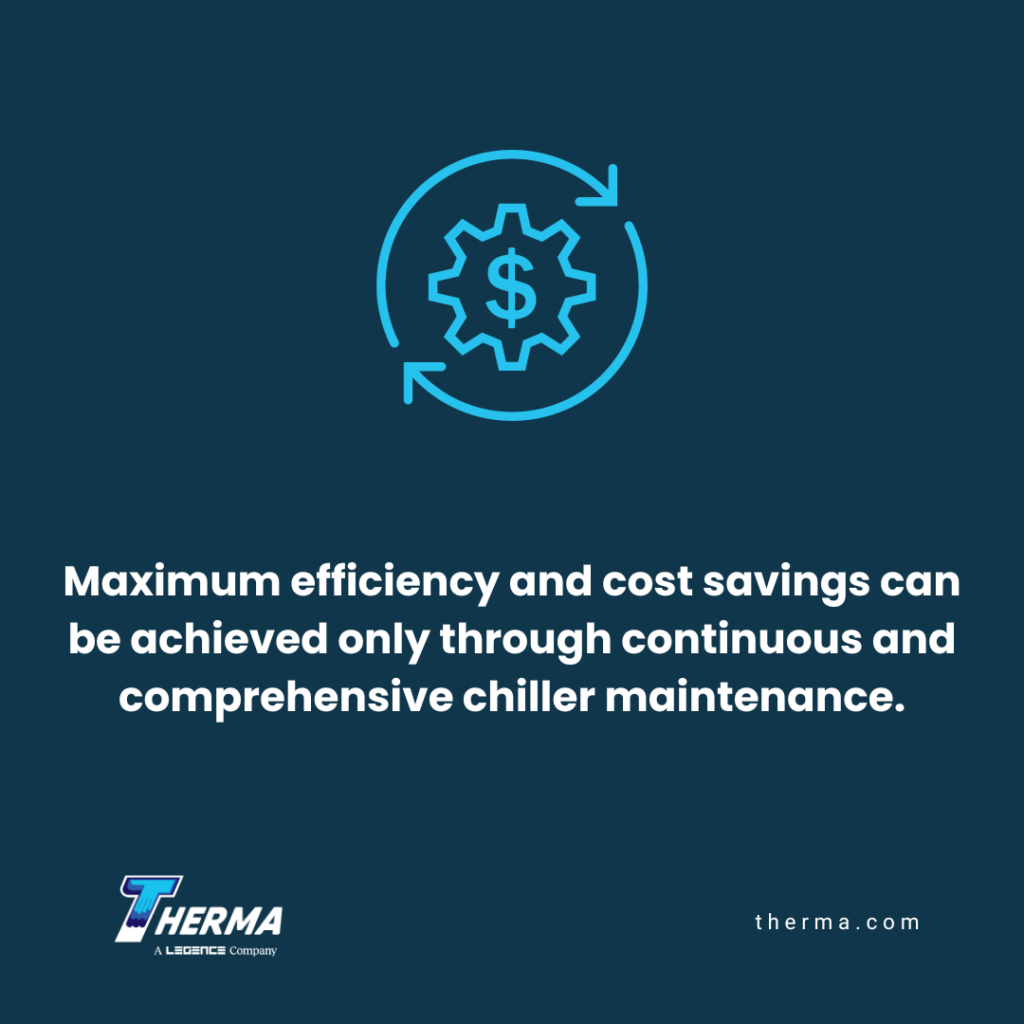HVAC chiller maintenance is central to maximum system performance, helping to optimize energy efficiency and control energy costs. In this article, we’ll look at key maintenance and how to get the most out of your system’s HVAC chiller.
Commercial HVAC systems are designed to both dehumidify and cool your building or facility while keeping an eye on crucial HVAC targets: cost-effectiveness and optimal interior temperature. An optimally maintained chiller used in the HVAC system is critical to achieving these goals.
What Is An HVAC Chiller & How Does It Work?
An HVAC chiller is found in the cooling systems of commercial buildings and facilities. These components can create the cooling effects necessary to remove heat gained through solar glazing, equipment, lighting, and electronics.
Commercial HVAC chillers come in two types, water-chilled and air-chilled. They function with a similar purpose to transfer heat from indoor spaces and exhaust it to the outdoors.
HVAC systems can harness heat transfer energy principles through vapor compression or vapor absorption, by implementing an HVAC chiller to help maintain comfortable indoor temperatures.
When coolant circulates through various components of an HVAC chiller, its properties change. As pressure changes occur, the coolant goes from a liquid to a gas state by boiling in the evaporator. It’s here the refrigerant absorbs heat, causing a temperature drop.
In the compressor, the coolant is removed from the evaporator but keeps its low pressure. The compressor simultaneously raises the pressure in outgoing refrigerant vapor to release heat when it reaches the condenser.
The refrigerant transitions from gas to a liquid state when it condenses, in the condenser, and its heat is carried away by the cooling air or water medium.
All this happens in a seamless progression with an HVAC chiller operating at peak levels.
Air-Cooled vs. Water-Cooled Chillers
An air-cooled chiller typically funnels the refrigerant through coils with air forced over and across them by high-power fans that remove heat— venting to the exterior of the building.
Air-cooled chillers are useful in small to medium-sized facilities. They require less space and water and are typically less expensive than water-cooled chillers but have shorter lifespans.
A water-cooled chiller involves a second heat transfer from the refrigerant to the water. It’s sent up and circulated through a tower to remove the heat that radiates into the air above ground level.
Water-cooled chillers are found in medium to large facilities such as shopping malls, hospitals, airports, and hotels. Where adequate water supply facilitates the use of this chiller type, this equipment can be a consistent and efficient choice. They will typically last longer than air-cooled chillers with regular maintenance.
Both types of cooling systems require maintenance to maintain operational efficiency.
Ongoing Chiller Maintenance
Maximum efficiency and cost savings can be achieved only through continuous and comprehensive chiller maintenance. This maintenance can be both preventive (regularly scheduled based on best practices) and predictive (based on sensor data from within the system, which is an early warning indicator of an impending breakdown.)
Preventative Maintenance
With preventive maintenance, you’ll be able to anticipate the following tasks as required at regular intervals:
- Inspection and cleaning of condenser coils in air-cooled systems. Coils should be clog-free allowing air to pass freely;
- Inspection and replacement of damaged or worn fans, fan arrays, or fan components for air-cooled systems;
- Ensure proper water flow and prevent fouling or scaling in water-cooled systems by flushing condenser water loops;
- Water treatment–including glycol dosing–to keep water-cooled systems free from bacterial growth;
- Leak testing will help you safeguard against refrigerant escaping from tubes and ensure that there aren’t any water leaks in water-cooled systems or air leaks in air-cooled systems.
Predictive Maintenance
Predictive maintenance can help reduce the risk of a system’s otherwise unanticipated catastrophic failure and improve efficiency by monitoring every component of the chiller from the coolers to the refrigerant tubes.
- Monitored fan efficiency. Fans operating below optimal speeds can cause a loss of efficiency for the air cooler system.
- Monitored water usage. Increased evaporation at the tower level, causing water usage to rise, is a sign of poor water cooler efficiency.
- Monitored refrigerant levels. A proper refrigerant charge can positively impact energy efficiency by reducing cooling costs by up to 5-10%.
Advancements in Chiller Technology
The future of HVAC and chiller optimization hinges on the Internet of Things (IoT), which can track, analyze, and report data that enables predictive preventive maintenance. Building engineers can visualize critical HVAC assets in real-time and actual operating conditions can be determined based on an analysis of total power consumption and kW/ton efficiency.
Investing in IoT capability can be a significant advantage in chiller maintenance and extension of chiller lifespan extension. Keeping every component operating at peak performance means reducing HVAC energy consumption costs while extending the number of years between complete chiller replacements.
Are you looking to maximize your HVAC chiller? Therma’s HVAC experts are ready to help. Get in touch today.








